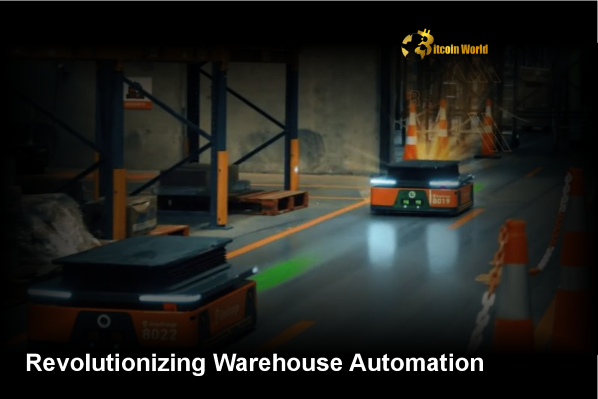Revolutionizing Warehouse Automation: Warp Robotics Unlocks Efficiency
0
0
BitcoinWorld

Revolutionizing Warehouse Automation: Warp Robotics Unlocks Efficiency
In the dynamic world of logistics, companies constantly seek innovation to gain an edge. Warp, a company founded in 2021, initially focused on streamlining shipping supply chains through its network. Now, it’s taking a significant leap by integrating robots to enhance warehouse automation across its network.
Driving Supply Chain Efficiency with Robotics
Warp’s core mission is to make shipping more efficient and reduce costs for its customers, which include major enterprises like Walmart, Gopuff, and HelloFresh. Daniel Sokolovsky, co-founder and CEO of Warp, explained that the company is always looking for improvements. With advancements in AI, new opportunities for automation emerged.
While long-haul trucking and short-range delivery present unique challenges for automation, Warp identified the workflows inside its warehouses as an area ripe for change. This focus on optimizing internal processes is key to boosting overall supply chain efficiency.
Experimenting with Warehouse Automation
Warp began its journey into automation by setting up a test warehouse in Los Angeles. They installed cameras and used computer vision technology to create a virtual representation of the facility – essentially a digital twin. This simulation environment allowed them to experiment freely.
Sokolovsky described the initial phase as throwing ideas at the wall to see what worked. An early attempt to train humanoid robots to use traditional pallet jacks proved unsuccessful. However, Warp found success by adapting off-the-shelf robots and retrofitting them with additional technology.
Leveraging AI and Robotics for Logistics Automation
Warp is breaking down complex logistics problems into smaller, manageable components that systems can understand and execute. Sokolovsky stated that they are now using AI, in various forms like voice, text, email, and phone calls, alongside robotics, to manage tasks such as unloading, storing, and reloading freight. This integrated approach to logistics automation aims to achieve their goals quickly without needing to hire more people for these specific tasks.
The company believes this blend of AI and robotics is crucial for future growth and efficiency in the logistics sector.
The Benefits of Warp Robotics and Future Plans
Troy Lester, Warp co-founder and CRO, highlighted the benefits of this automation for Warp’s underlying warehouse partners. These partners, who operate most of the warehouses in Warp’s network outside the LA test facility, frequently face staffing issues. Lester noted that the labor performing the work often finds it undesirable.
Introducing Warp robotics provides an opportunity to empower these partner businesses with robotic kits. These kits not only enhance Warp’s network but also improve the partners’ operations with other companies, helping to reduce labor costs and address staffing challenges.
Warp recently secured a $10 million Series A funding round, co-led by Up.Partners and Blue Bear Capital, to support this automation initiative. The company is currently testing several robot versions and plans ambitious deployment this year. The Los Angeles test facility is already fully autonomous, and Warp intends to roll out these robots to warehouses in its core network locations: Los Angeles, Chicago, New Jersey, Dallas, and Miami.
For now, Warp plans to keep this technology within its network, viewing it as a competitive advantage for itself and its partners. Sokolovsky emphasized that Warp is first and foremost a logistics company focused on servicing customers, and this automation is a natural evolution built upon their existing system and ecosystem, rather than simply being a robotics or AI company selling technology externally.
AI in Warehouses: A Competitive Edge
The integration of AI in warehouses is not just about replacing tasks; it’s about creating smarter, more efficient operations. Warp’s approach, starting with a digital twin for experimentation and then deploying adapted off-the-shelf robots, demonstrates a practical path to automation. This strategy allows them to refine workflows and integrate AI for decision-making in real-time warehouse operations.
By focusing on automating internal warehouse processes, Warp is building a network that is more resilient to labor shortages and capable of handling freight more quickly and accurately. This provides a significant competitive edge in the demanding logistics market.
In summary, Warp is making significant strides in enhancing warehouse automation through the strategic deployment of robotics and AI. By creating digital twins, experimenting with robot types, and focusing on core warehouse workflows, the company aims to dramatically improve supply chain efficiency and provide a competitive advantage to its network partners. This move into logistics automation, powered by Warp robotics and integrated AI in warehouses, positions Warp at the forefront of modern freight handling, promising faster, more reliable, and cost-effective services for its high-profile clients.
To learn more about the latest AI trends, explore our article on key developments shaping AI features.
This post Revolutionizing Warehouse Automation: Warp Robotics Unlocks Efficiency first appeared on BitcoinWorld and is written by Editorial Team
0
0
 Manage all your crypto, NFT and DeFi from one place
Manage all your crypto, NFT and DeFi from one placeSecurely connect the portfolio you’re using to start.






